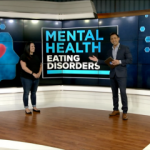Recognizing Body Dysmorphic Disorder
Alsana’s Diabulimia Treatment Program Provides Life-Saving Care For People Who Have Diabetes And Who Are Also Struggling With An Eating Disorder.

What is Body Dysmorphic Disorder?
Body Dysmorphic Disorder (BDD) is a mental health condition in which a person is preoccupied with one or more perceived defects or flaws in their physical appearance that are not noticeable or appear minor to others. These perceived flaws can cause significant distress and can lead to impaired social, occupational, and other areas of functioning.
People with BDD often spend a lot of time and energy trying to hide, cover up, or correct the perceived flaws and may engage in behaviors such as mirror checking, skin picking, excessive grooming, seeking reassurance, or cosmetic procedures. Despite these efforts, the person with BDD may still feel dissatisfied with their appearance and may continue to obsess over their perceived flaws.
What’s the Difference Between Body Dysmorphia and BDD?
“Body dysmorphia” is not a medically recognized term. The correct term for the condition is Body Dysmorphic Disorder (BDD). Therefore, there is no difference between body dysmorphia and BDD.
However, it’s worth noting that some people may use the term “body dysmorphia” to refer to a general feeling of dissatisfaction or discomfort with their physical appearance, which may or may not meet the diagnostic criteria for BDD. It’s important to recognize that while many people experience body dissatisfaction or concerns about their appearance at some point in their lives, not all of these experiences meet the criteria for a mental health disorder.
While some people may use the term “body dysmorphia” to refer to general feelings of dissatisfaction with their appearance, the correct term for the specific mental health condition is Body Dysmorphic Disorder (BDD).
BDD Prevalence
Body Dysmorphic Disorder (BDD) is a relatively common mental health condition in the United States. According to the National Institute of Mental Health (NIMH), an estimated 1.7% of adults in the United States experience BDD in a given year.
BDD affects people of all genders and can occur at any age, but typically begins in adolescence or early adulthood. It is estimated to affect approximately 1-2% of the general population and may be more common in people with a history of anxiety or depression.
The Impact of Social Media on Body Dysmorphic Disorder
There is evidence to suggest that social media can contribute to the development and exacerbation of Body Dysmorphic Disorder (BDD). One of the main ways that social media affects BDD is through the promotion of unrealistic beauty standards, which can lead individuals to feel dissatisfied with their appearance and overly preoccupied with their perceived flaws.
In a study published in the International Journal of Eating Disorders, researchers found that social media use was associated with increased body dissatisfaction and a greater likelihood of developing disordered eating behaviors, which are both risk factors for BDD (Fardouly et al., 2015).
Another study, published in the Journal of Eating Disorders, found that individuals with BDD reported spending significantly more time on social media than those without the disorder and that social media use was positively associated with BDD symptoms (Perloff et al., 2019).
Furthermore, social media may reinforce the tendency to compare oneself to others, which can contribute to negative self-evaluation and body dissatisfaction. A study published in the Journal of Adolescence found that adolescents who spent more time on social media reported greater body dissatisfaction and an increased desire to lose weight, which are both associated with BDD (Fardouly et al., 2015).
While social media can be a source of support and connection for individuals with BDD, it is important to be aware of the potential negative effects and to use social media in a way that supports one’s mental health.
What Causes BDD?
The exact causes of BDD are not fully understood, but it is thought to be related to a combination of genetic, environmental, and psychological factors. Some potential risk factors include a family history of BDD or other psychiatric disorders, a history of bullying or teasing related to appearance, and a tendency towards perfectionism or obsessive-compulsive behaviors.
Eating Disorders and BDD
Body Dysmorphic Disorder (BDD) and eating disorders are both mental health conditions that can involve distorted body image and preoccupation with appearance.
Research has found that people with BDD are at increased risk for developing eating disorders. This may be because the preoccupation with perceived flaws in appearance that is characteristic of BDD can overlap with the preoccupation with weight, body shape, and food that is characteristic of eating disorders.
It’s worth noting that while BDD and eating disorders can co-occur, they are distinct conditions with different diagnostic criteria. Eating disorders involve a range of behaviors and attitudes related to food and weight, while BDD is specifically focused on preoccupation with one or more perceived flaws in appearance.
However, because BDD and eating disorders can both involve significant distress and impairment, it’s important for mental health professionals to carefully assess for both conditions and provide appropriate treatment. Treatment for BDD and eating disorders may involve a combination of medication and psychotherapy, such as cognitive-behavioral therapy (CBT) or exposure and response prevention (ERP) therapy. Treatment may also involve addressing any co-occurring mental health conditions, such as anxiety or depression.
Risk Factors for Body Dysmorphic Disorder
Body Dysmorphic Disorder (BDD) is a mental health condition that can develop in anyone, regardless of age, gender, or background. However, certain factors may increase the risk of developing BDD. Some of the known risk factors for BDD include:
Genetics
BDD appears to run in families, suggesting a genetic component to the disorder.
Neurobiological factors
Differences in brain structure and function have been observed in individuals with BDD, suggesting that neurobiological factors may play a role in the development of the disorder.
Environmental factors
Trauma or abuse, bullying, or social pressure to conform to certain beauty standards can contribute to the development of BDD.
Other mental health conditions
Individuals with other mental health conditions such as depression, anxiety, or obsessive-compulsive disorder (OCD) may be at higher risk for developing BDD.
Low self-esteem
People with low self-esteem or a negative body image may be at higher risk for developing BDD.
Body Dysmorphic Disorder Warning Signs
Preoccupation with appearance
A person with BDD may spend a significant amount of time and energy obsessing over their appearance, often for several hours a day. This can include checking their appearance in mirrors or other reflective surfaces, seeking reassurance from others, or avoiding situations where their perceived flaws may be visible.
Perceived defects or flaws
People with BDD often focus on specific body parts, such as their skin, hair, nose, or other facial features. They may perceive these features as abnormal or defective, even if they appear normal or only slightly different from what is considered “average” or “normal”.
Repeated attempts to conceal or correct perceived flaws
A person with BDD may engage in repetitive behaviors such as applying makeup or other coverings, changing their hairstyle or clothing, or even seeking cosmetic procedures in an attempt to correct or conceal the perceived defect or flaw.
Avoidance of social situations
The preoccupation with appearance and fear of being seen in public can lead to avoidance of social situations, such as going to work or school, going out with friends, or attending social events.
Impaired functioning
BDD can interfere with a person’s ability to function in their daily life, affecting their work or school performance, relationships, and self-esteem. It can also lead to other mental health conditions such as depression or anxiety.
BDD and the LGBTQ+ Community
Increased Vulnerability Among LGBTQ+ Individuals
Research has suggested that members of the LGBTQ+ community may be at higher risk for developing Body Dysmorphic Disorder (BDD) due to factors such as discrimination, stigma, and social pressure to conform to idealized beauty standards.
A study published in the journal Body Image found that gay and bisexual men were more likely to experience body dissatisfaction and BDD symptoms compared to heterosexual men. Similarly, a study published in the Journal of Gay & Lesbian Mental Health found that transgender individuals may be at higher risk for BDD due to the distress associated with gender dysphoria and the pressure to conform to societal expectations of gender.
Additionally, the experience of being a member of a marginalized group can exacerbate the impact of BDD on an individual’s mental health. Stigma and discrimination can contribute to feelings of isolation and low self-esteem, which can in turn worsen symptoms of BDD.
It’s important to note that these risk factors do not mean that all LGBTQ+ individuals will develop BDD. However, it’s important for mental health professionals to be aware of the unique challenges faced by members of the LGBTQ+ community and to provide culturally sensitive and affirming care.
Help for Individuals with Body Dysmorphic Disorder
Recovery from BDD is possible with time, effort, and proper support. It may involve setbacks and challenges along the way, but with the right support and resources, it is possible to manage the symptoms of BDD and improve overall well-being.
Treatment for BDD typically includes a combination of medication and psychotherapy, such as cognitive-behavioral therapy (CBT) or exposure and response prevention (ERP) therapy. Medications that may be used to treat BDD include selective serotonin reuptake inhibitors (SSRIs), which are commonly used to treat anxiety and depression.
It’s important to seek help from a mental health professional if you or someone you know is experiencing symptoms of BDD. Early diagnosis and treatment can help to prevent the condition from worsening and can improve the quality of life.
Alsana offers a free 24/7 Live Chat for those seeking help.
Sources:
Fardouly, J., Diedrichs, P. C., Vartanian, L. R., & Halliwell, E. (2015). Social comparisons on social media: The impact of Facebook on young women’s body image concerns and mood. Body Image, 13, 38-45. https://doi.org/10.1016/j.bodyim.2014.12.002
Perloff, R. M., Fetters, M. D., & Scott, M. D. (2019). Body dysmorphic disorder, social media, and cosmetic treatment: A survey of 996 cosmetic patients. Journal of Eating Disorders, 7, 22. https://doi.org/10.1186/s40337-019-0251-7
American Psychiatric Association. (2013). Diagnostic and statistical manual of mental disorders (5th ed.). https://doi.org/10.1176/appi.books.9780890425596
Phillips, K. A. (2005). The broken mirror: Understanding and treating body dysmorphic disorder. Oxford University Press.
National Eating Disorders Association. (2021). Body dysmorphic disorder (BDD). https://www.nationaleatingdisorders.org/body-dysmorphic-disorder
Grant, J. E., Odlaug, B. L., & Kim, S. W. (2010). A double-blind, placebo-controlled study of the opiate antagonist, naltrexone, in the treatment of body dysmorphic disorder. Psychopharmacology, 212(5), 611–619. https://doi.org/10.1007/s00213-010-1971-6
Sarwer, D. B., & Crerand, C. E. (2008). Body dysmorphic disorder and appearance enhancing medical treatments. Body Image, 5(1), 50–58. https://doi.org/10.1016/j.bodyim.2007.09.002
Phillips, K. A., McElroy, S. L., Keck, P. E. Jr., & Pope, H. G. Jr. (1993). A comparison of delusional and nondelusional body dysmorphic disorder in 100 cases. Psychopharmacology Bulletin, 29(2), 181–186.
Gualtieri, J., & Andris, D. A. (2011). Body dysmorphic disorder in different settings: A systematic review. Journal of Psychiatric Practice, 17(3), 170–182. https://doi.org/10.1097/01.pra.0000393843.65139.11
American Psychological Association. (2021). LGBTQ+ psychology. https://www.apa.org/topics/lgbtq
Tylka, T. L., & Subich, L. M. (2004). Exploring the construct of positive body image. Journal of Social and Clinical Psychology, 23(3), 322–349. https://doi.org/10.1521/jscp.23.3.322.35434
Szymanski, D. M., & Gupta, A. (2009). Examining the relationship between multiple internalized oppressions and African American lesbian, gay, bisexual, and questioning persons’ self-esteem and psychological distress. Journal of Counseling Psychology, 56(1), 110–118. https://doi.org/10.1037/a0013094






